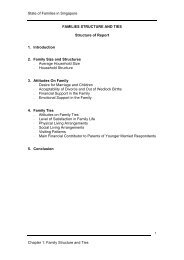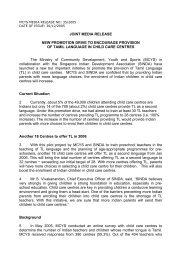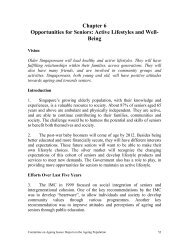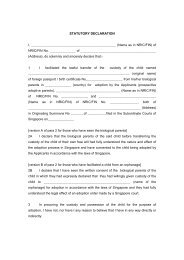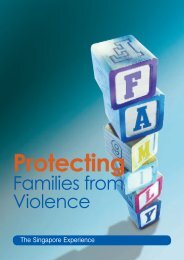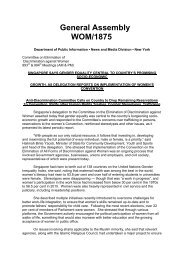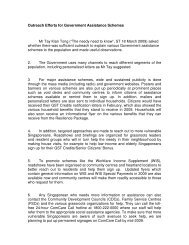Executive Summary - Ministry of Social and Family Development
Executive Summary - Ministry of Social and Family Development
Executive Summary - Ministry of Social and Family Development
Create successful ePaper yourself
Turn your PDF publications into a flip-book with our unique Google optimized e-Paper software.
EXECUTIVE SUMMARYSTATE OF THE FAMILYIN SINGAPOREThis Report on the State <strong>of</strong> the <strong>Family</strong> in Singaporepresents key trends on the family in Singapore. Itdraws data <strong>and</strong> statistics from administrative sources,survey findings <strong>and</strong> published studies. It was put togetherby the <strong>Ministry</strong> <strong>of</strong> Community <strong>Development</strong>, Youth <strong>and</strong>Sports (MCYS) <strong>and</strong> the Committee on the <strong>Family</strong> toupdate Singaporeans on how our families are doing.<strong>Family</strong> ties <strong>and</strong> families in Singapore are still strong. Thetrends show that the majority <strong>of</strong> Singaporeans enjoy aclose knit family <strong>and</strong> the family continues to be pillar <strong>of</strong>emotional <strong>and</strong> financial support for most. This isencouraging news but we recognize that families todayface stresses <strong>and</strong> strains in meeting the challenges <strong>of</strong>heavier work commitments <strong>and</strong> changing social values.While marriage <strong>and</strong> parenthood remain important lifegoals, many young Singaporeans are choosing to delayfamily formation while they pursue higher education <strong>and</strong>their careers. Our lives have become more hectic <strong>and</strong>many Singaporeans face a time squeeze as they try tobalance their responsibilities between work <strong>and</strong> family.The family is the cornerstone <strong>of</strong> our society. It providesan important buffer for individuals <strong>and</strong> for societies intimes <strong>of</strong> major challenges <strong>and</strong> turmoil. As a community,we must remain committed to strengthening Singapore’sfuture by strengthening our families. I hope that theinformation found in this report can help encourage morediscussion on what we can all do to build strong <strong>and</strong>stable families in Singapore.I would like to thank Mr. Willie Cheng, Chairman <strong>of</strong> theCommittee on the <strong>Family</strong> as well as members <strong>of</strong> theCommittee on the <strong>Family</strong>. Their role as an advisory bodyfor family policies <strong>and</strong> programmes has contributedtowards the strengthening <strong>of</strong> families in Singapore.Mrs Yu-Foo Yee ShoonMinister <strong>of</strong> StateMINISTRY OF COMMUNITY DEVELOPMENT,YOUTH AND SPORTSThe Big PictureHAPPY together – that is what families in Singapore are,generally.Most households have a family nucleus, Singaporeans havepro-family attitudes, <strong>and</strong> there is a strong consensus that thefamily is the buttress <strong>of</strong> emotional <strong>and</strong> financial support.Families are also close-knit with married children staying intouch with their parents. Relationships between parents <strong>and</strong>their children are also healthy. For instance, most teenagersfeel appreciated <strong>and</strong> can get along with their familymembers.But with more dual-income families, greater educationexpectations <strong>and</strong> time pressures, some troubling signs arebeginning to emerge.There are more broken marriages among couples who havebeen married for less than 10 years <strong>and</strong> those who havebeen together for more than 20 years. S<strong>and</strong>wiched couples(i.e. those who have to take care <strong>of</strong> their elderly parents <strong>and</strong>their own children) feel the squeeze in juggling the dem<strong>and</strong>s<strong>of</strong> work <strong>and</strong> family commitments.These findings are highlighted in the State <strong>of</strong> the <strong>Family</strong> inSingapore (SFS) 2004 report. Compiled by the <strong>Ministry</strong> <strong>of</strong>Community <strong>Development</strong>, Youth <strong>and</strong> Sports (MCYS) <strong>and</strong>the Committee on the <strong>Family</strong>, it draws from several surveys<strong>and</strong> published data.1
EXECUTIVE SUMMARY: STATE OF THE FAMILY IN SINGAPOREThe family exists at the heart <strong>of</strong> allsocieties. It is the first <strong>and</strong> mostbasic institution to which every one <strong>of</strong>us belongs. It is therefore importantthat we develop a keen underst<strong>and</strong>ing<strong>of</strong> how families in Singapore arefaring – what are their strengths <strong>and</strong>what are the challenges they face.We should be heartened that thesurvey shows that families inSingapore are, on the whole, doingwell. At the same time, we shouldalso worry that the trends are creepingin the wrong direction. Unless weproactively address this, like theproverbial frog in the beaker <strong>of</strong> waterthat is slowly but surely being boiledalive, the outlook for families ageneration from now would not berosy.How do we ensure that familiesremain healthy <strong>and</strong> well? Much <strong>of</strong> ouractions today address the ailments <strong>of</strong>divorces, abortion, delinquency, etc.Perhaps we should also focus some <strong>of</strong>our energies on more important butless urgent aspects <strong>of</strong> preventivemeasures such as education <strong>and</strong> theupbringing <strong>of</strong> our young. At the root<strong>of</strong> this, is holding high our familyvalues.<strong>Family</strong> values start with each <strong>of</strong> us,not just talking about it, but acting inthose beliefs. Our examples will makemore impressions on the young thanour talk. It’s a small step that each <strong>of</strong>us can continually take that canperhaps make a big difference.We hope this report would helpdevelop a better underst<strong>and</strong>ing <strong>of</strong> thestate <strong>of</strong> the institution <strong>of</strong> the family inSingapore <strong>and</strong> in so doing, help take astep towards building strong <strong>and</strong>stable families, <strong>and</strong> a stronger societyin Singapore.Willie ChengChairmanCOMMITTEE ON THE FAMILYBackgroundThe State <strong>of</strong> the <strong>Family</strong> in Singapore report presents keynational trends on the family.Covering primarily the period between 2001 <strong>and</strong> 2003, thestudy draws data <strong>and</strong> statistics from government agencies,survey findings <strong>and</strong> published studies.Some <strong>of</strong> the key studies include:• Survey on the <strong>Social</strong> Attitudes <strong>of</strong> Singaporeans (SAS) –a series <strong>of</strong> longitudinal studies conducted annually byMCYS since 2001, it covers the attitudes <strong>of</strong> Singaporeanstowards a wide range <strong>of</strong> topics including family, ethnicrelations <strong>and</strong> life satisfaction.• <strong>Social</strong> Aspects <strong>of</strong> Public Housing in Singapore –Kinship Ties <strong>and</strong> Neighbourly Relations – the 2000Housing <strong>and</strong> <strong>Development</strong> Board monograph delved intothe social aspects <strong>of</strong> public housing, covering some 8,690households.• 2002 National Youth Survey –a nationwide survey by the National Youth Council <strong>of</strong> morethan 1,500 young people aged 15-29 years, sought toidentify their attitudes towards school, home <strong>and</strong> familyvalues, among other things.Positive Structures<strong>and</strong> TiesSingaporeans have strong pro-family attitudes, with a consensus thatthe family is crucial for emotional <strong>and</strong> financial support.STRONG BONDSThe Survey on the <strong>Social</strong> Attitudes <strong>of</strong> Singaporeans (SAS) 2000 foundthat 8 in 10 households have a family nucleus. A nucleus could comprisea married couple, with or without unmarried children, <strong>and</strong> a parent orgr<strong>and</strong>parent. It could also include one parent with unmarried children.9 in 10 people viewed their families as being close-knit <strong>and</strong> were satisfiedwith their family life, according to findings in the SAS 2001-2003.2
EXECUTIVE SUMMARY: STATE OF THE FAMILY IN SINGAPORESingaporeans’Attitudes Towards Emotional Support In The <strong>Family</strong>Statements% Agree2001 2002 2003I have a close-knit family. 97 97 93My family members tell me their personal problems. 88 88 86When I am troubled, I would talk to one or more <strong>of</strong> 88 88 85my family members.Source: Survey on <strong>Social</strong> Attitudes <strong>of</strong> Singaporeans (SAS) 2001, 2002, 2003There is also wide consensus that the family is the primary channel through which values can be transmitted across generations<strong>and</strong> that gr<strong>and</strong>parents play an important role.NURTURING CHILDRENThe SAS surveys also found that 99 per cent <strong>of</strong> Singaporeans agreed that parentsshould nurture their children to develop positive values. Most felt that the rightvalues could be effectively taught in the family context through parents <strong>and</strong>gr<strong>and</strong>parents.In fact, 99 per cent <strong>of</strong> those surveyed in SAS 2002 <strong>and</strong> 2003 agreed that parentsshould communicate regularly with their young children. For instance, parentsshould ask their children how their day went or talk about common activities – busyschedules notwithst<strong>and</strong>ing.In fact, most felt happiest when theywere with their children. In the<strong>Ministry</strong>’s Study on Marriage <strong>and</strong>Procreation (SMP) in 2004, aboutthree quarters <strong>of</strong> the 3,000 marriedrespondents surveyed agreed with thestatements:• “I believe that in our modern world,the only place where you can feelcompletely happy <strong>and</strong> at ease is athome with your children” <strong>and</strong>• “I always enjoy having childrennear me”.Children<strong>Family</strong> structure <strong>and</strong> ties playa critical role in the well-being<strong>and</strong> development <strong>of</strong> children.The trends show that childrenin Singapore are healthy withaccess to adequate healthcare<strong>and</strong> education.A 2000 Singapore PressHoldings survey <strong>of</strong> 1,742Primary 4 to 6 children,showed that three-quarters <strong>of</strong>them enjoyed close bonds withtheir parents <strong>and</strong> siblings.Despite the stresses <strong>of</strong> acompetitive education system,both the SPH Survey <strong>and</strong> aUNICEF Survey in 2001, <strong>of</strong>children aged 9 to 17 years,found that the majority werealso doing well emotionally<strong>and</strong> reported to being happy“most <strong>of</strong> the time”.3
EXECUTIVE SUMMARY: STATE OF THE FAMILY IN SINGAPORENURTURING TEENSParents also have a moderately good relationship with theirteenaged children. Findings from the 2002 National Youth Survey(NYS) 1 showed that 9 in 10 teenagers were happy with their lives.The same ratio also felt appreciated by their families <strong>and</strong> 7 in10 said that they could get along with their family members.They were also close to their mothers – a third would turn totheir mothers for advice on a problem <strong>and</strong> two fifths, forimportant life decisions.1The National Youth Survey findings used in this report only apply to respondentsaged 15-18 years old.Quality <strong>of</strong> <strong>Family</strong> RelationshipAgree (Percent)Disagree (Percent)Male Female Male FemaleI feel appreciated for who I am. 93 90 1 3We enjoy having dinner together <strong>and</strong> talking. 78 79 3 7The only time I’m being noticed is when I have a problem. 23 17 61 64We can’t get along with each other. 15 10 72 72Total Sample 206 187 206 187CARING FOR PARENTSThe ties between married children <strong>and</strong> their parents also remained strong, according to aHousing <strong>and</strong> <strong>Development</strong> Board (HDB) survey, <strong>Social</strong> Aspects <strong>of</strong> Public Housing inSingapore: Kinship Ties <strong>and</strong> Neighbourly Relations.The 2000 monograph showed that even married children who lived apart, rather thannext door to their parents, kept in touch through frequent visits <strong>and</strong> contact or had thegr<strong>and</strong>parents assist in caring for their gr<strong>and</strong>children. For instance, three fifths <strong>of</strong>married children (59 per cent) visited their parents at least weekly.Adult children also continued to care for their parents financially <strong>and</strong> emotionally.According to the 2000 Census, three quarters <strong>of</strong> the elderly aged 65 years <strong>and</strong> abovenamed their children as their main source <strong>of</strong> income. This is consistent with SAS 2001<strong>and</strong> 2002 in which 99 per cent agreed that it was the children’s duty to give monthly allowances to their elderly parents.The Census also found that nearly three quarters <strong>of</strong> the senior citizens also lived with their children <strong>and</strong> only 9 percent <strong>of</strong> thenon-ambulant elderly lived alone.These findings indicate that intergenerational ties are still positive in Singapore <strong>and</strong> filial piety remains a key moral in society.4
EXECUTIVE SUMMARY: STATE OF THE FAMILY IN SINGAPORESome Stresses EmergingSome troubling signs, which indicate that marriage, family formation <strong>and</strong> the family unit will face increasing challenges in thelong term, have begun to emerge. The concerns include an increasing rate <strong>of</strong> divorces, more parenting pressures <strong>and</strong> greatertensions faced by s<strong>and</strong>wiched couples.DIVORCESSingapore’s divorce rate has been rising steadily since 1980. The Report <strong>of</strong> Marriages <strong>and</strong> Divorces, from the Department <strong>of</strong>Statistics (DOS), showed a doubling – from 3.8 to 8 divorces per 1,000 married women from 1980 to 2003. Children bear morethan the fair share <strong>of</strong> burdens associated with the weakening <strong>of</strong> marriages. In 2003, at least 5,900 children under the age <strong>of</strong> 18witnessed their parents’ divorce.Starter MarriagesCouples are splitting up even before they reach their 10th wedding anniversary. Nine per cent <strong>of</strong> civil couples married in 1994divorced before their 10th year together compared to 7 per cent for the 1987 cohort. For Muslim marriages, 16 per cent <strong>of</strong> the1994 cohort dissolved their marriage within the first ten years compared to 11 percent <strong>of</strong> the 1987 cohort.Divorces by Marriage Cohort (First 10 years <strong>of</strong> marriage)181615 15141413 121611 1112AMLA1088 88 86897 74Women’s Charter201986 1987 1988 1989 1990 1991 1992 1993 1994 1995Marriage CohortSource: Registry <strong>of</strong> Marriages/Registry <strong>of</strong> Muslim MarriagesOf particular concern is the trend <strong>of</strong> “starter marriages” – divorces in nuptials less than five-years-old where couples usuallyhave no dependent children. We are seeing an increasing number <strong>of</strong> young non-Muslim marriages (under 5 years) break up. Themajority <strong>of</strong> these early non-Muslim divorcees (73 per cent) do not have children. Such early break ups are pervasive in theUnited States <strong>and</strong> have been documented by Pamela Paul, an editor at consumer trends publication, American Demographics.She interviewed 60 young divorcees <strong>and</strong> found that the couples were “mesmerized by the romantic idea <strong>of</strong> marriage <strong>and</strong> blindedto reality”.5
EXECUTIVE SUMMARY: STATE OF THE FAMILY IN SINGAPOREEmpty NestersThe proportion <strong>of</strong> couples who break up after 20 or more years <strong>of</strong> marriage has nearly doubled – from 11.4 per cent in 1990 to20 per cent in 2002. Most <strong>of</strong> these divorcees are aged 50 years <strong>and</strong> above <strong>and</strong> the majority do not have dependent children below18 years old.This trend <strong>of</strong> “empty nest” divorces gives rise to an emerging group <strong>of</strong> elderly “singles”.25201510511.4 12.6 14.1 13.910.19.111.4Divorces among Marriages Lasting 20 Years or More10.116.610.619.511.420.3 21.6 21.2 20.321.5 21.6 2021.1Women’s Charter12.2Muslim Law Act01989 1990 1991 1992 1993 1994 1995 1996 1997 1998 1999 2000 2001 2002 2003 2004Year10.111.215Source: Report <strong>of</strong> Marriages <strong>and</strong> Divorces13.114.712.312.5PARENTING PRESSURESThere is no dearth <strong>of</strong> research to show that the quality <strong>of</strong> relationships between parents <strong>and</strong> their teenaged children act as a bufferagainst emotional distress, substance abuse, early sexual activity <strong>and</strong> suicidal thoughts or attempts. As today’s families juggle theincreasing dem<strong>and</strong>s <strong>of</strong> work <strong>and</strong> family life, that buffer has had to absorb more shocks.Results from the 2002 NYS showed that teenagers, though happy with life, felt a sense <strong>of</strong> alienation from their families.Nearly 23 per cent <strong>of</strong> male <strong>and</strong> 17 per cent <strong>of</strong> female teenagers indicated that the only time they were noticed was when they hada problem <strong>and</strong> when they could not get along with family members.Teenagers also reported finding it harder to talk to their fathers compared to their mothers. Nearly 44 per cent would turn to afriend first if they had a problem. Mothers came second (33 per cent) <strong>and</strong> then, fathers (11 per cent).The number <strong>of</strong> juvenile <strong>of</strong>fenders arrested, aged between 7 <strong>and</strong> 15 years, rose 42 per cent from 2001 to 2003. A total <strong>of</strong> 2,515teenagers were nabbed in 2003 – up from 1,461 in 2001, according to the Singapore Police Force.Teenage pregnancy <strong>and</strong> abortion trends also indicate that teen sexuality is an area to be watched. The number <strong>of</strong> teenage birthspeaked at 952 in 2000, from 704 in 1997, before dipping to 849 in 2002.There were 1,626 teenage abortions in 2001 – up from 1,368 in 1998. Teenage abortions accounted for 13 per cent <strong>of</strong> allabortions carried out in Singapore in 2002.6
EXECUTIVE SUMMARY: STATE OF THE FAMILY IN SINGAPORENumber <strong>of</strong> Teenage Abortions between 1998 to 2002Number <strong>of</strong> Teenage Abortions2000150010005000199819992000 2001 2002YearSource: <strong>Ministry</strong> <strong>of</strong> HealthSANDWICHED FAMILIESWith Singapore’s fast-greying society, a significant proportion <strong>of</strong> couples find themselves squeezed in a situation where theyhave to take care <strong>of</strong> their elderly parents as well as their own children.With smaller families <strong>and</strong> the decline in the traditional extended family model, s<strong>and</strong>wiched couples find that they have fewerfamily members to turn to for help. The primary caregiver is also <strong>of</strong>ten in the position <strong>of</strong> having to negotiate on care-givingarrangements with other family members, leading to tension in the family.Also, with the dual-income trend, s<strong>and</strong>wiched families find it tough to cope with their own needs – housing, financial, medical<strong>and</strong> emotional – <strong>and</strong> those <strong>of</strong> their ageing parents <strong>and</strong> their growing children.Other FindingsSome other signs are also starting to emerge. These include delays in marriage <strong>and</strong> having children, weaker bonds among singleswith their family members, <strong>and</strong> changing values towards family norms.LATE MARRIAGE AND CHILD-BEARINGThe SAS results 2001-2003 showed that Singaporeans desire nuptials <strong>and</strong> 8 in 10 would prefer to get married than to remain single.Despite the positive attitudes towards marriage <strong>and</strong> parenthood, delayed marriage <strong>and</strong> childbearing remain the dominant trends.Although the SMP study found that nearly 4 out <strong>of</strong> 5 people felt that a three-child family was “just nice”, in reality, individualsplanned to have just two children on average.The constraints cited for their choice: not enough time <strong>and</strong> energy for children, <strong>and</strong> concerns about financial support.7
EXECUTIVE SUMMARY: STATE OF THE FAMILY IN SINGAPORESINGLES AND THE FAMILYWhile the SAS surveys consistently showed that the most Singaporeans, including singles have high levels <strong>of</strong> communicationwithin the family <strong>and</strong> enjoyed close ties.All three SAS surveys (2001-2003) showed that singles would talk about their problems to their family members. 8 singles in 10singles compared to 9 in 10 married people said they would confide in their family members <strong>and</strong> that they would hear from theirfamily members when the latter had personal problems.The findings are encouraging as they show that most singles enjoy strong family ties, with support felt between them <strong>and</strong> theirfamily members.MORE LIBERAL VALUESWhile the majority <strong>of</strong> Singaporeans hold positive attitudes towards family, the single, younger <strong>and</strong> better-educated cohorts appearto be holding more liberal values towards divorce <strong>and</strong> having children out-<strong>of</strong>-wedlock.In all three SAS studies, only 48 per cent <strong>of</strong> singles – compared to 67 per cent <strong>of</strong> married people – frowned on divorce. And 7 in10 singles disapproved <strong>of</strong> unmarried persons having babies. The ratio was 8 in 10 for the married group.Although such attitudes do not necessarily translate into behaviour, they indicate that societal norms are shifting <strong>and</strong> may haveimplications on behaviour long-term.Singles responding to “It is better to get married than to remain single”,By Gender <strong>and</strong> Education (% Agree)Education 2001 2002 2003ConclusionsMale Female Total Male Female Total Male Female TotalPrimary & None 50 23 33 68 63 65 77 55 67Secondary/ITE 85 67 76 78 68 74 75 67 71Junior College/Pre-U 90 79 81 98 65 78 88 65 77Polytechnic 79 72 77 78 56 67 85 65 77University 71 69 71 84 79 82 82 61 72Source: Survey on <strong>Social</strong> Attitudes <strong>of</strong> Singaporeans (SAS) 2001, 2002, 2003On the whole, there is a positive picture <strong>of</strong> families in Singapore. The dominance <strong>of</strong> families with a stable family structure,Singaporeans’ pro-family attitudes, <strong>and</strong> strong consensus that the family is the buttress <strong>of</strong> emotional <strong>and</strong> financial support augurwell for families here. Surveys also show that most Singaporeans feel they have close-knit families <strong>and</strong> are satisfied with theirfamily life. Intergenerational families <strong>and</strong> ties remain strong. This positive state <strong>of</strong> affairs indicates that the family remains thefirst line <strong>of</strong> care <strong>and</strong> support.Nevertheless, heavy work commitments <strong>and</strong> the stresses <strong>of</strong> modern family life, <strong>and</strong> changing social values are putting strains onstrong <strong>and</strong> stable family ties. The slow but steady rise in divorces is also <strong>of</strong> concern. The Many Helping H<strong>and</strong>s approach <strong>of</strong> rallyingfamilies, the people, private <strong>and</strong> public sector must continue, so that Singapore will continue to be a Great Place for Families.A full copy <strong>of</strong> the report on the State <strong>of</strong> the <strong>Family</strong> can be found at: www.c<strong>of</strong>.org.sg<strong>Family</strong> Policy Unit<strong>Ministry</strong> <strong>of</strong> Community <strong>Development</strong>, Youth <strong>and</strong> Sports512 Thomson Road 10th Storey MCDS Building S298136



